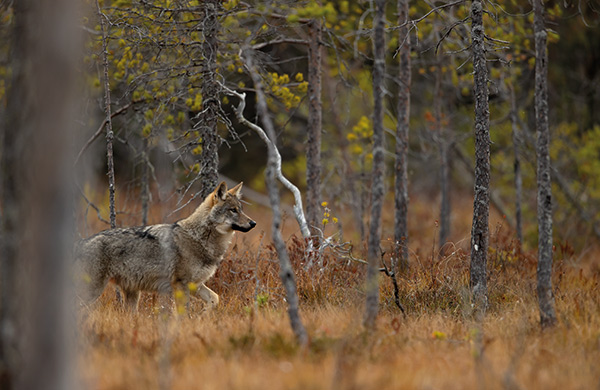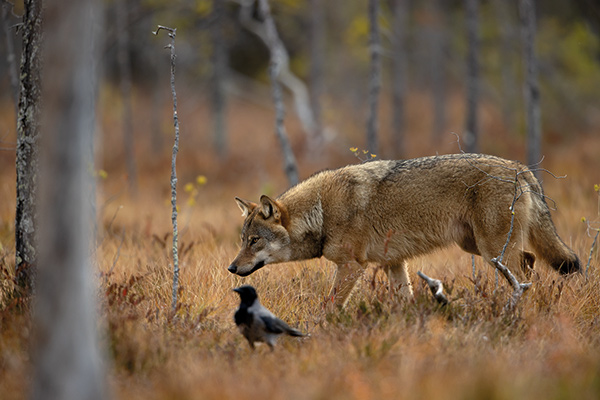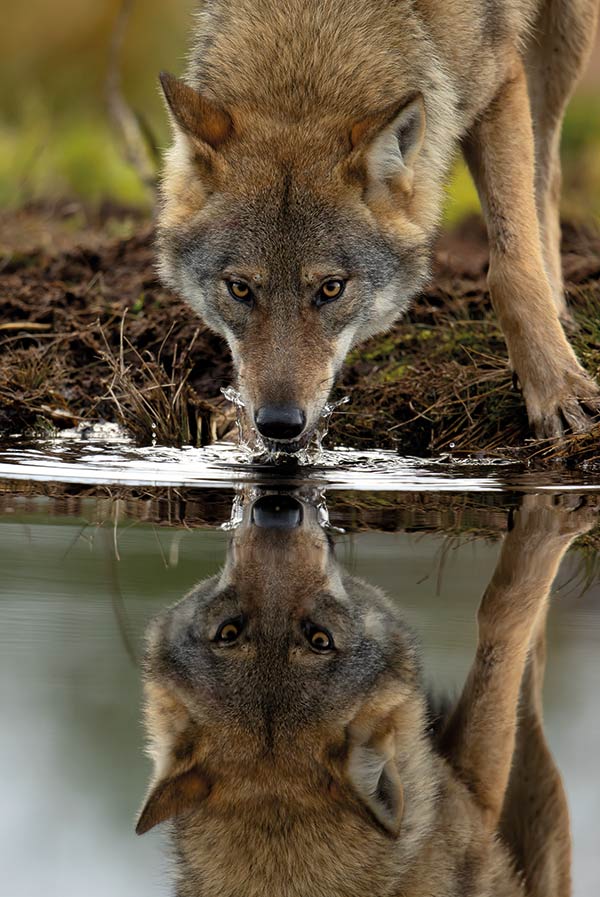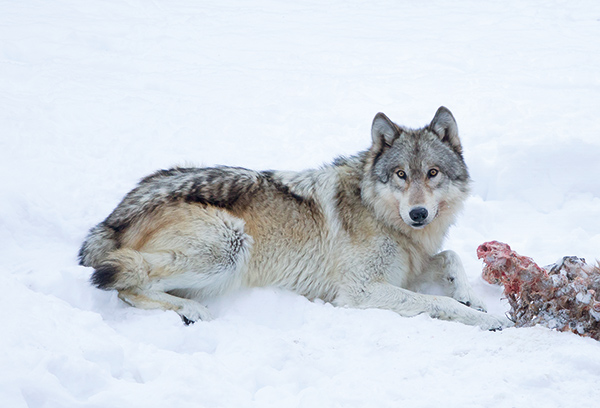Subtotal: $
Checkout-

Saskatchewan, Promised Land
-

The Plants Can Talk
-

Saving the Soil, Saving the Farm
-

The Wonder of Moths
-

The Leper of Abercuawg
-

Dandelions: An Apology
-

A Wilderness God
-

Why I Hunt
-

Reading the Book of Nature
-

Breakwater
-

Lambing Season
-

Earthworks Urban Farm
-

Are You a Tree?
-

Practicing Christianity
-

Who Gets to Tell the Story?
-

A Medievalist Looks for the Image of Christ
-

In Defense of Chastity
-

Poem: “Let Them Grow”
-

Poem: “Squall”
-

Readers Respond
-

GEDs for Myanmar Migrants
-

Inside Nyansa Classical Community
-

Watching the Geminids
-

A World Full of Signs
-

Covering the Cover: The Riddle of Nature
-

Back from Walden Pond
-

Can Masculinity Be Good?
-

Nature Is Obsessed with Me
-

Ancient Songs in the Desert
-

The Sadness of the Creatures

Meeting the Wolf
Should we go back to nature? Saint Anthony and Saint Francis show how to make peace with it instead.
By Greta Gaffin
February 28, 2024
Available languages: Deutsch
Next Article:
Explore Other Articles:
The last wolf in Boston was killed in 1657. I live in Boston, a world of stone and brick and metal and glass. Many modern people live in similar surroundings.
And we desire to escape. We want to flee this manmade environment – loud and overstimulating and chaotic – and retreat to what is peaceful and calm.
Some of our overstimulation comes from a barrage of messages about nature. We’re bombarded with them. Natural living. Returning to the land. “It’s just so important to me to get out into nature” – you hear it from both secular and religious people; it’s put in terms of mental or spiritual health or both.
I live in this society, and I want to do this too. But what does it mean to “get into nature”?
Recently I went on a retreat at the Society of Saint John the Evangelist, an Episcopal monastery in Cambridge, Massachusetts. I took some time to walk along the street in front of the monastery, enjoying the plants. Nature, after all. The thought came to me that it is very nice of the Cambridge Department of Public Works to maintain the plants for me to enjoy.
The pleasant rolling hill near where I grew up has that shape because the hill is built on top of what was once Boston’s landfill. The city forest has paths maintained by the Department of Conservation and Recreation. Untrammeled nature? Maybe not. Beautiful? Healing? Absolutely.
But that’s Boston. I was also, briefly, an intern at the Community of Saint Mary, another Episcopal religious house in Sewanee, Tennessee, a long way away from urban life. It got a lot darker there than I was used to. I stayed in a little cottage down the path from the convent, and the gardener warned me that there might be snakes. I was afraid walking back from the main convent building to the cottage: What if I stepped on one? Snakes in rural Tennessee are not like Boston’s humble garter snake. If you drove out from the convent into the nearby hollows, you would find Christians who take up serpents because the Bible tells them to, and sometimes they die.

European wolf. Photograph by Danny Green.
A couple of years later I spent a month in rural Ireland and found myself again walking down poorly lit rural paths at night, once again worrying about snakes. But each time I would stop myself and remember: Saint Patrick got rid of those. Not like in Tennessee. Natural historians tell us that there had in fact been no snakes in Ireland since well before Patrick arrived. Natural historians would know. But I thought of Patrick nonetheless. For someone who arrived in Ireland from Great Britain or Scandinavia, where there are poisonous snakes, not having any really would’ve been miraculous.
Saint Francis is now remembered as a charming patron saint of animals, a man who preached to the birds. People bring their pets to church once a year on his feast day to be blessed. On Saint Francis’s feast day, even the Episcopal bishop of East Tennessee might handle serpents… to bless them as pets.
In his own time, though, Francis was beloved for his taming of wild animals. The story goes that around 1220, a wolf was terrorizing the Italian city of Gubbio. It snapped up livestock and eventually graduated to humans. They became his preferred meals, and at last, no human who dared venture outside the city walls was safe. Francis, who was living in the city at the time, told the townsfolk he was going to parley with the wolf, and passed beyond the city walls, citizens trailing a little way behind. He went up to the wolf’s lair. When it came out, it made as if to devour him, but he made the sign of the cross and commanded it in the name of God to stop its depredations. It meekly laid its head at his feet. But Francis was not quite done. “Brother wolf,” he said – the citizens were close enough to hear this part –
thou hast done much evil in this land, destroying and killing the creatures of God without his permission; yea, not animals only hast thou destroyed, but thou hast even dared to devour men, made after the image of God; for which thing thou art worthy of being hanged like a robber and a murderer. All men cry out against thee, the dogs pursue thee, and all the inhabitants of this city are thy enemies; but I will make peace between them and thee, O brother wolf, if so be thou no more offend them, and they shall forgive thee all thy past offenses, and neither men nor dogs shall pursue thee any more.
The wolf indicated his agreement to these terms, bowing his head again to Francis. “As thou art willing to make this peace,” said the saint,
I promise thee that thou shalt be fed every day by the inhabitants of this land so long as thou shalt live among them; thou shalt no longer suffer hunger, as it is hunger which has made thee do so much evil; but if I obtain all this for thee, thou must promise, on thy side, never again to attack any animal or any human being; dost thou make this promise?
Francis stretched out his hand, and the wolf placed his forepaw in it, sealing the oath between them.
Today we care deeply about conservation. We care about the conservation of wolves. In medieval Europe, and in North America until the twentieth century, people tended to care more about the conservation of their livestock, and of their own skins. Wolves were dangerous to both.
This is why the last wolf in Boston was killed in 1657. But one night last year, I was walking from the Boston University School of Theology to my dorm room on BU’s Fenway campus. That involves walking past part of the Emerald Necklace, the chain of local parks designed by Frederick Law Olmsted, who also designed Central Park. Everything there is meant to be there, just as Olmsted planned it, including the parts that are meant to look wild.
And there was a coyote.
Coyotes do not eat adult humans. I was not in danger. But I was afraid.

Wolf in autumn. Photograph by Danny Green.
And I was in part afraid because I was not in “nature.” I was two blocks from Fenway Park and new, gleaming skyscrapers and the sleek lab buildings of BU’s attempt to become the biotech hub of the United States. You go out into nature; you choose to be there. And I had not chosen to be there. I had chosen to be here.
The coyote had presumably chosen to be here as well, with or without my permission, or the state’s. He was presumably here to hunt rabbits, the adorable bunnies I enjoyed seeing hop all over the campus’s neatly manicured lawns. But you don’t have rabbits without predators – not naturally, anyway.
In Leviticus 26, God says to the Israelites: “If you follow my statutes and keep my commandments and observe them faithfully… I will grant peace in the land, and you shall lie down, and no one shall make you afraid; I will remove dangerous animals from the land, and no sword shall go through your land.” Removing wild beasts, then, is regarded as in the same category as ending war.
The most common wild animal an urban dweller sees today is, if not the rat, the pigeon. But they’re feral (that is, descended from the domesticated bird), so they’re not really wild. Or it might be the squirrel. Olmsted and his ilk intentionally reintroduced the squirrel to urban parks in the nineteenth century. Architects like Olmsted saw the dirty, industrialized world a growing percentage of Americans lived in, and wanted to reintroduce beauty and a simple, rustic character. The squirrel is harmless. It may be annoying when it digs up your garden, but if you live in Boston, your garden, if you have one, is not your sole source of food. You may as an urban gardener feel that you are at war with the squirrels. But you’re really not. Not the kind of war that God would have to step in and stop.
The desert fathers went out into the desert because it was wild and because nobody else wanted to be there. It was not like the pleasant retreat we might take in the Adirondacks. It was very much a sacrifice to move there.
The problem was not just the wild beasts of the desert, although they were a problem too, but the landscape itself. The people of Egypt have huddled along the banks of the Nile for thousands of years for a reason: its water brings survival. The farther one gets from the river, the harder it is to survive. To live in the desert, to live “in nature” and outside of civilization, is to be on the precipice of death. Jesus went there. The Israelites passed through it.
And yet this way of life was appealing, perhaps especially to those who could’ve easily chosen not to live it. Saint Anthony of the Desert, one of the early monastics, grew up in a wealthy family. After his parents died, he heeded Matthew 19:21: “If you want to be perfect, go, sell what you have and give to the poor, and you will have treasures in heaven.” That is what he did. He sold his family’s property. He went into the desert. He did not want acolytes. He had them anyway. They saw his holiness, which followed from his going out into nature, because that going out into nature was a meaningful sacrifice for Christ.

Wolf and reflection. Photograph by Danny Green.
One of his modern acolytes – in a way – is Chris McCandless, immortalized in Jon Krakauer’s bestseller Into the Wild. After graduating from Emory University, McCandless gave the rest of his college fund to charity. He became a wanderer. He eventually decided to move to the Alaskan bush with no supplies, hoping to live off the land. He found an abandoned school bus to live in. He lived there for 113 days. Then he died of starvation.
Like the graves of many early saints, the bus became a shrine. Pilgrims visited from all over the world hoping to retrace his steps, to the point where the state of Alaska removed the bus. There had been too many search-and-rescue missions to save visitors who were themselves about to become victims of nature.
The writer Bobby Angel describes McCandless as “a Saint Francis who had never encountered Christ.” There’s that difference between McCandless and Saint Anthony as well, but there’s another one also. Anthony did not live a totally isolated life. He did not sustain himself off the land. If he had tried, he would have died, just as McCandless did.
McCandless was inspired not by those early saints but by Henry David Thoreau, who “went to the woods” because he
wished to live deliberately, to front only the essential facts of life, and see if I could not learn what it had to teach, and not, when I came to die, discover that I had not lived. I did not wish to live what was not life, living is so dear; nor did I wish to practice resignation, unless it was quite necessary. I wanted to live deep and suck out all the marrow of life, to live so sturdily and Spartan-like as to put to rout all that was not life, to cut a broad swath and shave close, to drive life into a corner, and reduce it to its lowest terms.
But Thoreau, of course, was writing from Walden Pond, from the hut he built on his friend Ralph Waldo Emerson’s land. It was around a twenty-minute walk to his mother’s house. Over the two years that he lived there, she did his laundry. The train into Boston ran along one side of the pond. Thoreau spent his time writing, as well as doing some land-clearing for Emerson in lieu of rent. Anthony spent a significant amount of his time weaving baskets to exchange for food and other necessities. Other desert monks did too, and many of them complained about having to spend so much time weaving compared to prayer.
The Sayings of the Desert Fathers, a selection of stories about the earliest hermits, gives an anecdote about Abba John the Dwarf. He told his older brother he wanted to be like an angel, who did not have to work but could ceaselessly praise God. He went to the desert. Within a week he was back, and his brother told him that he was a man, not an angel, and men have to work to eat.
Our ideas about nature are often drawn from Romanticism, from the writings of men of means who longed for an idealized English countryside. They had to contend with the smog and soot and stench that spared no one in London. Nature seemed better.
One of the appeals of “going into nature” is getting away from the rat race. But it’s hard to sustain yourself out there – a lot harder than sending emails. Anthony would have had a much easier life if he had kept his family’s land and overseen its cultivation. He gave up a lot to live this life of prayer in the desert. So did Francis, who famously tore off his expensive aristocrat’s clothing in the streets of Assisi, renouncing his patrimony along with his tunic, leaving them to go preach to the animals, who would presumably be less disturbed by public nudity. Of course, he did put clothes on again later – he wasn’t naked when he struck the bargain with the wolf.
Our ideas about nature are often drawn from Romanticism, from the writings of men of means who longed for an idealized English countryside (an English countryside that, of course, had already been shaped by human cultivation for thousands of years). They had to contend with the smog and soot and stench that spared no one in London. Nature seemed better. It was also free, they imagined, of the political machinations and intrigues and elaborate etiquette of the city. They believed that rural people lived simple, uncomplicated lives free of the influences of modernity. But those Romantic writers and artists who did go “back to the land” tended not to fully do the work of wrenching a living from it.
The nineteenth-century British yeoman, who had to deal with this fetishizing of his toil, was no medieval serf, let alone one of the first farmers ten thousand years earlier, whose agricultural villages rich Victorian men were beginning to unearth. He had all the advantages of the Industrial Revolution, which had been as much a revolution in agricultural technology as anything else. He was growing food for the 78 percent of the British population who no longer lived this “natural” lifestyle on the land, a population that had tripled over the century between 1750 and 1850.
And the last wolf in England was killed in the fourteenth century.

Wolf feeding, northern Europe. Photograph by Danny Green.
In Genesis God says “Rule over every living thing that moves on the earth” (1:28). Much ink has been spilled over how a Christian theology of dominion, derived from this verse, has led to widespread destruction of animal and plant life. But control over nature is what facilitates modern life and our ability to enjoy pleasant strolls in the woods, not to mention not dying from bacteria and viruses that would otherwise deliver pestilence of biblical proportions.
There are numerous downsides to our modern urban lifestyle. We are surrounded by screeching cars and trains. We breathe in exhaust and chemical fumes. We need supplements and expensive lamps to deal with how little sunshine we get. Running from one thing to the next, we eat processed foods with low nutritional value. But we (rural people included) benefit from the developments of the industrialized world, like clean water and warm houses and antibiotics. There are good things about the unnatural world that we live in.
Back in 1675, King Charles II told architect Christopher Wren that Saint Paul’s Cathedral was “very artificial, proper, and useful”; by “artificial” he meant that it had been designed with art and skill. The next time you’re enjoying nature, remember that the park you’re in is also, to some degree, artificial. And like Saint Paul’s Cathedral, that’s not a bad thing.
But if you see a coyote … stop. It’s only natural.
Already a subscriber? Sign in
Try 3 months of unlimited access. Start your FREE TRIAL today. Cancel anytime.










































Linda wilson
There is an essay by Mary Oliver called “A Few Words.” It begins “ “Nothing in the forest is charming. Gardens are charming, and man-made grottos, and there is a tranquility about some scenes of husbandry and agriculture that is charming--orderly rows of vegetation, or lazy herds, or the stalks of harvest lashed and leaning together. “And nothing in the forest is cute. The dog fox is not cute, nor the little foxes. I watch them as they run up and down the dune. One is carrying the soiled wing of a gull; the others grab onto it and pull. They fly in and out of the blond grasses, their small teeth snapping. They are not adorable, or charming, or cute. ”The owl is not cute. The milk snake is not cute, nor the spider in its web, nor the striped bass. Neither is the skunk cute, and its name is not "Flower." Nor is there a rabbit in the forest whose name is "Thumper," who is cute.” This article reminded me of Oliver’s essay. Nature is sublime. Sublime captures both beauty and horror, it captures the awesome aspect of both beauty and horror. Joseph Campbell in an interview with Bill Moyers mentioned a soldier who was asked to describe the Battle of the Bulge. He described it as sublime. As the article points out nature is beautiful and dangerous and deadly. The beauty of nature can be seductive and blind us to its dangers. But it is awesomely beautiful nonetheless. Thanks for this article. Cordially, J. D. Wilson, Jr.